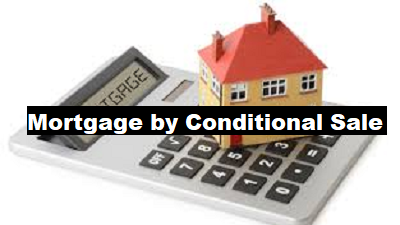Welcome to our guide on how to get a mortgage by conditional sale. If you’re considering purchasing a property and need financial assistance, a mortgage can be a great option. In this guide, we’ll walk you through the process of obtaining a mortgage through a conditional sale, providing you with the necessary information to make informed decisions. Whether you’re a first-time homebuyer or looking to invest in real estate, this article will serve as your comprehensive resource. Let’s get started!
Understanding Conditional Sale
Before we delve into the steps of obtaining a mortgage through a conditional sale, it’s important to understand what a conditional sale is and how it differs from a traditional mortgage. A conditional sale is a type of financing where the ownership of the property is transferred to the buyer, subject to certain conditions. These conditions typically include the payment of installments or the fulfillment of specific obligations. It’s crucial to comprehend these conditions before proceeding with a mortgage by conditional sale.

Here’s how a Mortgage by Conditional Sale Typically Works:
- Property Purchase: In this arrangement, the buyer identifies a property they wish to purchase. Instead of the lender directly providing funds to the buyer to purchase the property, the lender (often a bank or financial institution) purchases the property itself.
- Conditional Sale Agreement: The lender purchases the property from the seller and then sells it to the buyer at a higher price. This higher price includes the original purchase price plus a profit margin for the lender. The sale is structured as a deferred payment sale, where the buyer agrees to pay the purchase price to the lender in installments over an agreed-upon period.
- Ownership Transfer: Although the property is technically owned by the lender initially, the buyer takes possession of the property immediately after the conditional sale agreement is executed. The buyer becomes the beneficial owner of the property, while the lender retains legal title until the purchase price is fully paid.
- Payment Structure: The purchase price is divided into fixed installments, including both the principal amount and the profit margin for the lender. The buyer makes regular payments to the lender over the agreed-upon period until the entire purchase price is paid off.
- No Interest: Unlike conventional mortgages, which involve the payment of interest on the loan amount, a mortgage by conditional sale does not involve interest. Instead, the lender earns profit by selling the property to the buyer at a higher price than its original purchase price.
- Title Transfer: Once the buyer has made all the payments according to the agreed-upon terms, the legal title of the property is transferred from the lender to the buyer. At this point, the buyer becomes the outright owner of the property without any further financial obligations to the lender.
Evaluating Your Financial Situation
Prior to applying for a mortgage, it’s essential to assess your financial situation. This evaluation will help you determine your borrowing capacity and ensure that you can comfortably make the necessary payments. Here are a few key steps to consider:
- Analyze your monthly income and expenses to understand your financial capabilities.
- Calculate your debt-to-income ratio, which is the percentage of your monthly income that goes towards debt payments.
- Review your credit score and credit history to identify any red flags or areas for improvement.
- Consider saving for a down payment to reduce the loan amount and potentially secure better loan terms.
By thoroughly evaluating your financial situation, you’ll have a clearer understanding of your mortgage requirements and be better prepared for the application process.
Researching Lenders
Once you’ve assessed your financial situation, it’s time to research and choose a lender for your mortgage. Consider the following factors when evaluating potential lenders:
- Interest Rates: Compare interest rates offered by different lenders to ensure you obtain a competitive rate.
- Loan Terms: Assess the terms and conditions of the mortgage, including the length of the loan and repayment options.
- Customer Service: Research the reputation of the lender and their customer service quality.
- Additional Fees: Inquire about any additional fees or charges associated with the mortgage.
Take your time to review and compare multiple lenders to find the one that best suits your financial needs and requirements.
Preparing the Required Documents
Once you’ve chosen a lender, it’s crucial to gather all the necessary documents for the mortgage application. The specific documents required may vary depending on the lender and your personal circumstances, but here are some common documents you may need:
- Proof of Identity: Provide a valid identification document, such as a passport or driver’s license.
- Proof of Income: Submit recent pay stubs, tax returns, or any other documentation that confirms your income.
- Bank Statements: Include statements from your bank accounts to demonstrate your financial stability.
- Credit History: Obtain a copy of your credit report to provide to the lender.
- Property Information: If you have already identified a property, provide documents such as purchase agreement, valuation reports, and property details.
Make sure to organize these documents and have them readily available when applying for the mortgage to expedite the process.
Submitting the Application
Once you have gathered all the necessary documents, it’s time to submit your mortgage application. Contact your chosen lender and inquire about their application process. This may involve filling out an online form, meeting with a loan officer, or a combination of both. Follow the lender’s instructions carefully and provide accurate information throughout the application.
Some lenders may charge an application fee, so be prepared to make the payment if required. Additionally, ensure that you understand all the terms and conditions of the mortgage before signing any documents.
Undergoing the Mortgage Approval Process
After submitting your application, the lender will review your documents and evaluate your eligibility for the mortgage. This process may involve the following steps:
- Credit Check: The lender will review your credit history and score to assess your creditworthiness.
- Income Verification: Your income documents will be examined to ensure you have the financial capacity to repay the mortgage.
- Property Appraisal: If you have already chosen a property, the lender may conduct an appraisal to determine its market value.
- Assessment of Obligations: The lender will consider your existing debts and financial obligations to evaluate your ability to handle additional loan repayments.
During this process, the lender may request additional documents or information. Cooperate promptly and provide the necessary details to avoid any delays in the approval process.

Reviewing and Signing the Mortgage Agreement
If your mortgage application is approved, the lender will provide you with the mortgage agreement. Carefully review the agreement, including the interest rate, loan term, repayment schedule, and any other terms and conditions. If you have any questions or concerns, seek clarification from the lender before signing.
Ensure that you understand all the obligations and responsibilities outlined in the agreement. Once you are satisfied with the terms, sign the mortgage agreement to finalize the transaction.
Fulfilling the Conditions and Making Payments
As mentioned earlier, a mortgage by conditional sale comes with specific conditions that need to be fulfilled. These conditions may include making regular payments, adhering to property maintenance requirements, or meeting other obligations designated in the agreement.
It is crucial to fulfill these conditions and make your payments on time to maintain a favorable relationship with the lender and avoid any potential legal consequences. Consider setting up automatic payments or reminders to ensure you never miss any payment deadlines.
Congratulations on completing our guide on how to get a mortgage by conditional sale. By following the steps outlined in this article, you have gained valuable insights into the mortgage application process. Remember, obtaining a mortgage is a significant financial commitment, so it’s crucial to assess your situation carefully, choose a reputable lender, and understand all the terms and conditions involved. With the right knowledge and preparation, you’ll be well-equipped to navigate the mortgage journey and achieve your dream of owning a property. Good luck!
